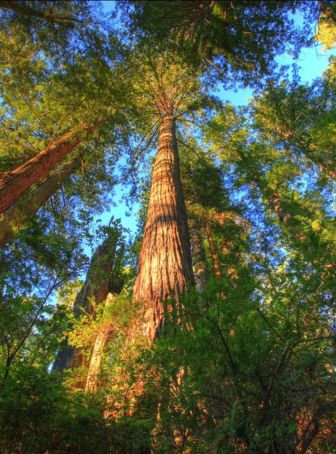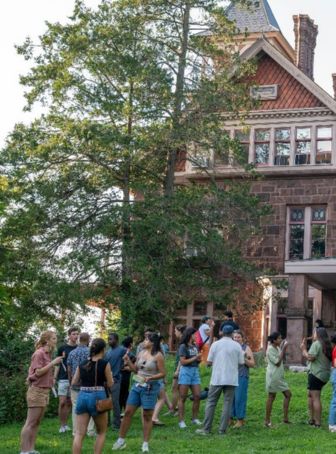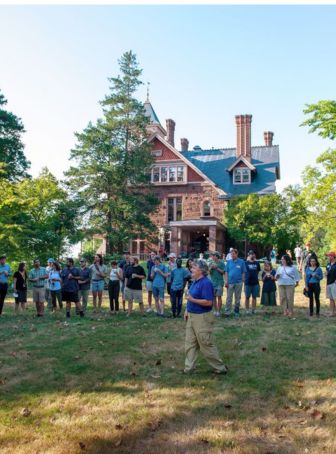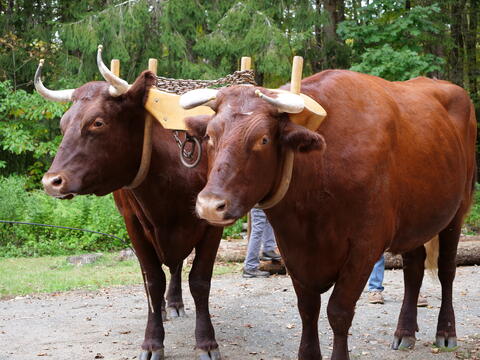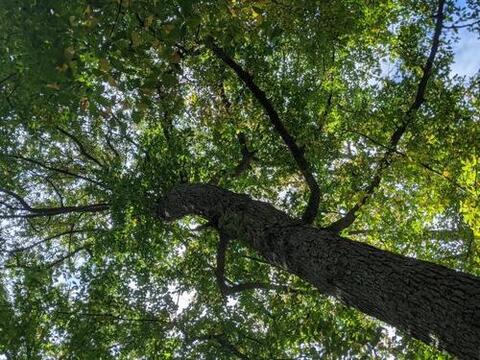
Jess Jones ’23 MF and Isaac Merson ’23 MEM
In the midst of the hardwood forests’ colorful fall dance, the Society of American Foresters (SAF) held their annual convention. The conference brought together foresters, academics, tree pathologists, entrepreneurs and forest-centered businesses. From November 3–6, the conference explored the theme of “Forests For All” through poster presentations, main stage speakers, and breakout discussions. In a field traditionally in service to landowners, how do we expand forestry to encompass all of us in relation with our beloved woods?
The conference was kicked off by Terry Baker ‘07 MF who serves as CEO of the Society. “We all have a right and a responsibility to these spaces, and what they mean to us, what they mean to the climate, what they mean to the wildfire concerns or hurricanes, and what they mean for sheer recreation and enjoyment.”
Later that night, Yale forestry students competed with other schools and alumni groups in the conference’s virtual Treevia Bowl. Snacks and laughs were had as students answered questions ranging from forestry equations to biology. Bringing in students and engaging younger members was a core focus of the conference this year – SAF membership tends to skew towards older professionals. Beyond this, students and alumni of The Forest School at the Yale School of the Environment had the chance to connect at a virtual alumni reunion.
Forest health and climate effects were big topics at this year’s convention, particularly among foresters associated with research universities. As the climate changes, the resilience of forest systems is being tested. Trees facing increased levels of disturbance are also more vulnerable to the pathogens spread by our global exchange of goods. Damian Adams, professor and associate dean for research at the University of Florida moderated a round table on forest health. Panelist Jodi Axelson, silviculture research leader for the British Columbia Provincial Government, encouraged practitioners to bring forest health conversations into their community, and emphasized the need to consider what the health of trees brought into a new environment will be when considering tree-planting as a climate mitigation tool.
Kier Klepzig, director of entomology and microbiology at The Jones Center at Ichauway, concurred with the need to consider plant pathogens which might arrive with any imported or exported trees, and suggested building strong connections with agricultural extension practitioners and scientists when considering management of pathogens. He spoke to the need for more forest health monitoring, so that these issues can be dealt with proactively. Enrico Bonello, professor of plant pathology at The Ohio State University agreed, calling for reciprocal sentinel plantings to monitor what pests we could potentially exchange through international trade in living trees and forest products. He said these plantings are now done by scientists in collaboration with China and Europe, but a well-maintained and well-structured planting through a government program might be able to do much better. Bonello pointed out legislation from Rep. Peter Welch (D-VT) introduced in 2019, which aims to respond to the emerald ash borer and also strengthen the USDA’s inspection process to protect forest health. Funding and structure are needed, perhaps in a program analogous to a CDC for forest health.
One mainstage panelist addressed a critical element of any forester’s job: Engaging with the people who own the land, or benefit from the services that forests provide. Phil Rigdon ’02 MF, deputy director of the Department of Natural Resources for the Yakama Nation, spoke of connecting with families as he actively manages land. In forming a direct line to the community, he can understand what they value in land management. According to Rigdon, forests play an important role in supporting clean water for salmon and hunting opportunities, and we must learn from historical tribal management practices: like whether they were burning or planting, and when. In a later talk on “The Many Dimensions of Ecosystem Services,” Carolyne Finney, author of White Spaces, Black Faces asked us how Black and Indigenous people can come together on issues of land justice. She and co-panelist Megan Yabarra, professor of Geography at the University of Washington, reminded us that landback – the returning of Indigenous lands – is not a metaphor, but a call to action.
How would forestry differ if there was more gender diversity within the field? According to speaker Jamie Dahl, only 17% of enrolled forestry students identify as women, and a mere 2.8% as LGBTQ+. Cathy Dummer, a wood-lot owner from Oregon, spoke to the importance of affinity groups in providing support for navigating the field as one who doesn’t match the stereotypical image of a forester. Having these community networks help her make better decisions on her land. In a networking roundtable, women opened themselves up to discussions on how we can support one another in a male-dominated field.
Sam Cook, executive director of Forest Assets for North Carolina State University, shared how his childhood passion for the outdoors now translates into his outreach work. He engages Black landowners in the Southeast on the value of owning and sustaining land – Black American land ownership has been in decline since 1910. Cook described how forestry can transform the risk and liability of owning land into value for the landowner and their community through techniques like conservation easements. Cook implored conference attendees to listen deeply to stakeholder stories. How can we foresters impart useful knowledge on the communities we serve?
Zack Parisa ’09 MFS, cofounder of forest carbon marketplace NCX, gave the closing plenary titled “The Value of Forests.” He acknowledged the changing conditions of forestry, emphasizing how technological developments can aid foresters in their service to landowners, a service which he said is the goal of forestry. We the authors are curious how landownership in the United States, given its current and historical meaning, can truly be viewed as Forests for All. Landownership is power, and it one that has been consistently revoked for many in this country. In fact, landownership has been used to marginalize and disenfranchise. When we serve landowners, are we missing the forest for the trees?
Whether you are curious about policy, forest health, business, and more, SAF’s annual convention offered food for thought and the chance to make new connections while revisiting old ones. Swing by next year– you never know who you may encounter in the alumni circles, or what fascinating project is being carried out in your region. Stay warm dear forest lovers!
